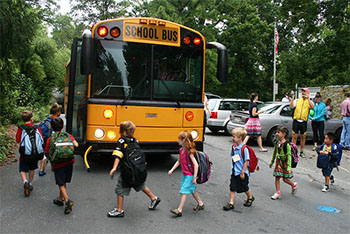
On the Way to School by Colleen Kraft, M.D.
 Now that the school year has started, it is good to know safety tips for all children as they travel to and from school. This includes safety on the school bus, in the car, riding a bike, or walking.
Now that the school year has started, it is good to know safety tips for all children as they travel to and from school. This includes safety on the school bus, in the car, riding a bike, or walking.
School Bus
- Children should always board and exit the bus at locations that provide safe access to the bus or to the school building.
- Remind your child to wait for the bus to stop before approaching it from the curb.
- Make sure your child walks where she can see the bus driver (which means the driver will be able to see her, too).
- Your child should not move around on the bus.
- Check on the school’s policy regarding food on the bus. Eating on the bus can present a problem for students with allergy and also lead to infestations of insects and vermin on the vehicles.

Car
- All passengers should wear a seat belt or use an age- and size-appropriate car seat or booster seat.
- Your child should ride in a belt-positioning booster seat until the vehicle’s seat belt fits properly (usually when the child reaches about 4′ 9″ in height and is between 8 to 12 years of age).
- Remember that many accidents occur while novice teen drivers are going to and from school. You should require seat belt use, limit the number of teen passengers, and do not allow eating, drinking, cell phone conversations even when using hands-free devices or speakerphone, texting or other mobile device use to prevent driver distraction..
Biking to School
- Practice the bike route to school before the first day of school to make sure your child can manage it.
- Always wear a bicycle helmet, no matter how short or long the ride.
- Ride on the right, in the same direction as auto traffic and ride in bike lanes if they are present.
- Use appropriate hand signals.
- Respect traffic lights and stop signs.
- Wear bright-colored clothing to increase visibility. White or light-colored clothing and reflective gear is especially important after dark.
- Know the “rules of the road.”
Walking to School
- Make sure your child’s walk to school is a safe route with well-trained adult crossing guards at every intersection.
- Identify other children in the neighborhood with whom your child can walk to school. In neighborhoods with higher levels of traffic, consider organizing a “walking school bus,” in which an adult accompanies a group of neighborhood children walking to school.
- Be realistic about your child’s pedestrian skills. Because small children are impulsive and less cautious around traffic, carefully consider whether or not your child is ready to walk to school without adult supervision. If the route home requires crossing busier streets than your child can reasonably do safely, have an adult, older friend or sibling escort them home.
- If your children are young or are walking to a new school, walk with them or have another adult walk with them the first week or until you are sure they know the route and can do it safely. If your child will need to cross a street on the way to school, practice safe street crossing with them before the start of school.
- Bright-colored clothing or a visibility device, like a vest or armband with reflectors, will make your child more visible to driver
The information provided is for general interest only and should not be misconstrued as a diagnosis, prognosis or treatment recommendation. This information does not in any way constitute the practice of medicine, or any other health care profession. Readers are directed to consult their health care provider regarding their specific health situation. Marque Medical is not liable for any action taken by a reader based upon this information.
